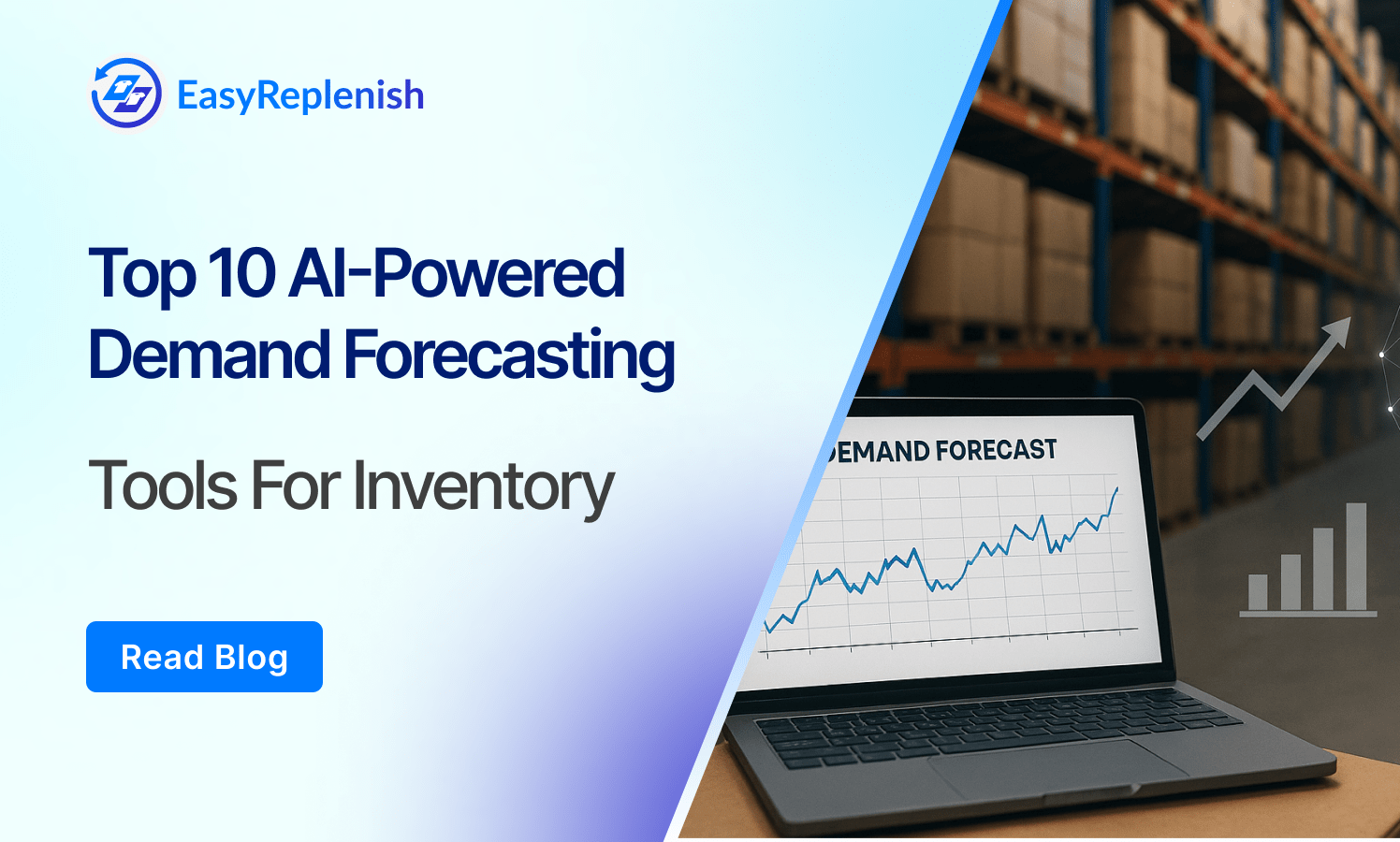Top 10 AI-Powered Demand Forecasting Tools For Inventory

In an era where market behavior can shift overnight — from viral social media trends to unpredictable supply disruptions — businesses can no longer rely on gut feeling or static spreadsheets to plan demand. Traditional forecasting methods, though foundational, often fail to capture the complexities of today’s multi-channel and fast-moving markets.
That’s where AI-driven demand forecasting tools step in. These platforms use advanced algorithms and real-time data to identify hidden patterns, learn from historical trends, and predict future demand with far greater accuracy than manual models ever could. Whether you’re managing seasonal collections in fashion, planning production cycles in FMCG, or preparing for event-driven demand spikes, the right forecasting tool can prevent overstocking, reduce lost sales, and unlock serious efficiency gains.
This guide breaks down everything you need to know — from what demand forecasting tools actually do, to a curated list of the top AI-powered platforms that are redefining how brands plan inventory, production, and replenishment. By the end, you’ll have a clear understanding of which tool fits your business goals and how to use forecasting as a true competitive advantage.
What Are Demand Forecasting Tools?
Demand forecasting tools are software solutions designed to predict future customer demand using a mix of historical sales data, market trends, and predictive analytics. Their core purpose is to help businesses align inventory, production, and procurement with real-world buying patterns — ensuring you have the right products, in the right quantities, at the right time.
At their simplest, these tools automate what many teams still do manually in spreadsheets: projecting future sales based on past performance. But modern forecasting tools — especially AI-powered systems — go much deeper. They pull in dynamic variables such as weather changes, marketing campaigns, regional trends, social sentiment, and macroeconomic data to refine forecasts continuously.
In industries like fashion, FMCG, electronics, and retail, where demand can shift rapidly due to seasonality or promotions, this accuracy is crucial. AI-driven forecasting doesn’t just predict what will sell — it helps teams understand why and when. The result: fewer stockouts, leaner inventory levels, and better capital utilization.
For example, a fashion brand using an AI tool might detect that pastel colors surge in demand every March across specific geographies, while a beverage company might anticipate a 30% spike in cold drink sales two weeks before a heatwave. Instead of reacting late, these brands act early — adjusting production, distribution, and marketing with precision.
Top 10 AI Demand Forecasting Tools
Explore the top 10 AI-powered demand forecasting tools that help businesses predict demand accurately, optimize inventory, and make data-driven decisions. This section highlights features, best use cases, and considerations for each platform to help you choose the right solution for your needs
1. Oracle Demand Management Cloud
Overview: A robust AI-powered platform designed for large-scale retail, manufacturing, and consumer goods companies. It integrates with ERP systems to deliver predictive demand forecasts.
Key Features / Strengths:
- AI and machine learning for accurate demand predictions
- Scenario modeling and what-if analysis for planning
- Real-time integration with sales, marketing, and supply chain data
- Multi-SKU, multi-location, and multi-channel forecasting
Best For / Use Cases:
Ideal for enterprises needing highly accurate demand forecasts across complex supply chains. Supports inventory optimization, promotion planning, and scenario simulations.
Limitations / Considerations:
Requires mature data infrastructure and dedicated teams for implementation.
2. SAP Integrated Business Planning (IBP)
Overview: Unified planning environment with advanced AI features for forecasting, demand sensing, and collaborative planning.
Key Features / Strengths:
- Real-time collaboration across sales, marketing, and supply chain teams
- Predictive analytics for seasonal and event-driven demand
- Scenario simulations and what-if analyses
- Modular and scalable for multinational brands
Best For / Use Cases:
Ideal for large enterprises with complex supply chains needing real-time scenario planning and cross-team alignment.
Limitations / Considerations:
Resource-intensive to implement and maintain; requires strong data governance.
3. EasyReplenish
Overview: EasyReplenish is an AI-powered demand forecasting and inventory optimization platform designed for fashion, DTC, and fast-moving consumer brands. It combines machine learning, historical sales, and promotional data to deliver accurate forecasts and automated replenishment recommendations.
Key Features / Strengths:
- AI-driven demand forecasting that accounts for seasonality, promotions, and new launches
- Inventory optimization across SKUs, sizes, and multiple warehouses
- Real-time integration with e-commerce platforms, ERP systems, and POS data
- Dashboards and visual analytics for planners and merchandisers
- Automated replenishment recommendations to reduce stockouts and overstock
Best For / Use Cases:
Ideal for fashion brands, DTC businesses, and retailers with high SKU velocity or seasonal fluctuations. Helps teams make proactive, data-driven decisions, reduce excess inventory, and improve cash flow.
Limitations / Considerations:
Primarily focused on fashion and DTC brands; may not offer full enterprise-scale functionality for very large, multi-industry global operations.
4. Blue Yonder Luminate Planning
Overview: AI-driven platform that generates granular forecasts considering promotions, seasonality, and market signals.
Key Features / Strengths:
- Machine learning-based demand sensing
- Scenario modeling for sales campaigns and market shifts
- Optimization for replenishment and allocation
- Strong in retail and CPG sectors
Best For / Use Cases:
Retailers and consumer goods companies looking to reduce stockouts and overstocks while responding to demand fluctuations.
Limitations / Considerations:
Accuracy depends on clean historical data; setup can be complex for smaller teams.
5. ToolsGroup SO99+
Overview: Focused on inventory optimization and demand planning, ToolsGroup SO99+ leverages AI to improve forecast accuracy and service levels.
Key Features / Strengths:
- Machine learning-driven demand sensing for SKU-level forecasting
- Multi-echelon inventory optimization
- Promotion and seasonal demand adjustments
- Scenario modeling for risk mitigation
Best For / Use Cases:
Suited for retailers and distributors managing large SKU portfolios with seasonal or promotional spikes. Helps reduce inventory carrying costs while improving fill rates.
Limitations / Considerations:
Requires detailed historical data for maximum effectiveness; some advanced features can be complex for smaller teams.
6. Kinaxis RapidResponse
Overview: A real-time supply chain planning platform with AI-driven demand forecasting, scenario simulation, and exception management.
Key Features / Strengths:
- Continuous monitoring and AI-enhanced demand predictions
- Scenario planning for supply disruptions or promotional event
- Integrated supply-demand balancing across multiple sites
- Rapid-response alerts for forecast deviations
Best For / Use Cases:
Designed for global manufacturers and distributors that require real-time visibility and predictive insights across the entire supply chain.
Limitations / Considerations:
Can be overkill for small to mid-sized businesses; best suited for complex multi-site operations.
7. NetSuite Demand Planning
Overview: A cloud-based demand planning solution that uses statistical modeling and AI to generate accurate forecasts across SKUs and locations.
Key Features / Strengths:
- Forecasting with seasonality, trends, and historical sales data
- Integration with NetSuite ERP for end-to-end inventory and supply chain management
- Collaborative planning across teams
- Scenario modeling for promotions and demand spikes
Best For / Use Cases:
Best suited for mid-sized to large businesses seeking integrated demand planning within their ERP environment. Particularly useful for multi-location retailers and distributors.
Limitations / Considerations:
Advanced features may require ERP customization and training for optimal use.
8. Lokad
Overview: A specialized AI-driven forecasting tool focused on inventory optimization and demand prediction for retailers and manufacturers.
Key Features / Strengths:
- Machine learning models for SKU-level and category-level forecasting
- Multi-echelon inventory optimization
- Integration with e-commerce platforms and ERPs
- Scenario simulations for promotions and seasonal variations
Best For / Use Cases:
Ideal for e-commerce retailers, consumer goods companies, and manufacturers who want granular, data-driven forecasts. Helps reduce overstock and improve fill rates.
Limitations / Considerations:
Requires clean historical data and some familiarity with data-driven forecasting to leverage full capabilities.
9. Google Cloud Forecasting
Overview: A cloud-based AI and ML-powered forecasting service designed to predict future demand for various industries using structured time-series data.
Key Features / Strengths:
- Leverages machine learning models like ARIMA, DeepAR, and Prophet for robust forecasting
- Scalable cloud solution for businesses of any size
- Integration with Google Cloud ecosystem for data pipelines and analytics
- Can handle multiple SKUs and seasonal trends effectively
Best For / Use Cases:
Best for tech-savvy teams and companies with strong data infrastructure. Flexible for retail, e-commerce, FMCG, and supply chain use cases.
Limitations / Considerations:
Requires technical expertise to set up models and interpret results; not a plug-and-play solution.
10. Custom Python/ML Forecasting Models
Overview: Tailor-made AI and machine learning models built using Python, R, or other ML frameworks, designed for companies with specific forecasting needs that off-the-shelf tools may not fully address.
Key Features / Strengths:
- Fully customizable forecasting models using ML algorithms like ARIMA, Prophet, LSTM, and XGBoost
- Ability to incorporate unique business variables such as promotions, events, and external market signals
- Scalability to handle multiple SKUs, categories, and locations
- Full control over model logic, assumptions, and outputs
Best For / Use Cases:
Ideal for data-driven companies with internal data science teams or those with unique demand patterns not fully supported by standard tools. Suitable for e-commerce, retail, FMCG, and any industry with complex, dynamic demand.
Limitations / Considerations:
Requires significant technical expertise and ongoing maintenance. Data quality and model tuning are critical to achieving accurate forecasts.
How to Choose the Best AI-Powered Demand Forecasting Tool
Selecting the right demand forecasting tool is critical to accurately predict demand, optimize inventory, and reduce stockouts or overstock. With a multitude of AI-driven and traditional solutions available, businesses must evaluate options carefully based on their unique needs, data infrastructure, and operational complexity.
1. Assess Your Business Requirements
Begin by identifying the specific forecasting needs of your organization. Are you managing seasonal products, promotional campaigns, or multi-location inventory? Understanding your SKUs, sales volume, and demand variability is essential. For example, a fashion retailer may need tools that handle high SKU turnover and seasonal spikes, while a beverage company may prioritize demand forecasting across regional distribution networks.
2. Evaluate AI and ML Capabilities
Advanced AI-powered tools can analyze historical sales, market trends, and promotional events to produce more accurate forecasts. Consider whether the tool uses machine learning algorithms like ARIMA, LSTM, Prophet, or hybrid models. AI capabilities are particularly valuable for businesses with fluctuating demand or multiple product categories.
3. Integration with Existing Systems
The forecasting tool should integrate seamlessly with your ERP, inventory management, and sales platforms. Smooth integration ensures real-time data flow, reduces manual work, and allows planners to make informed decisions faster. Tools like Oracle, SAP IBP, and EasyReplenish are known for strong integration capabilities.
4. Scalability and Flexibility
Choose a tool that can grow with your business. It should handle an increasing number of SKUs, locations, and data volume without compromising performance. Cloud-based platforms often provide better scalability and accessibility for teams across regions.
5. Usability and Team Adoption
A tool is only effective if your team can use it efficiently. Evaluate the user interface, ease of configuration, and availability of support or training. Tools that offer dashboards, visual analytics, and guided workflows can accelerate adoption and improve decision-making.
6. Cost vs Value
While price is important, focus on ROI rather than upfront cost. A tool that delivers accurate forecasts, reduces stockouts, and optimizes inventory can generate significant savings and revenue growth over time. Consider both licensing fees and the resources required for implementation.
7. Trial and Evaluation
Whenever possible, run a pilot or trial period to test the tool against your real data. Measure forecast accuracy, ease of use, and integration efficiency before committing to a long-term subscription.
By carefully evaluating these factors, businesses can select a demand forecasting tool that not only fits their current operations but also supports growth, improves inventory efficiency, and enables proactive decision-making.
Conclusion
Choosing the right demand forecasting tool is critical for accurate inventory planning, reducing stockouts, and optimizing cash flow. From enterprise-grade platforms like SAP IBP and Kinaxis to specialized solutions like EasyReplenish, each tool offers unique strengths tailored to different business needs.
By evaluating AI capabilities, integration options, scalability, and usability, businesses can select the solution that aligns with their operations and growth goals. Leveraging these tools effectively enables data-driven decisions, more precise demand forecasts, and ultimately, a stronger competitive edge.
FAQs
Q1. How do AI demand forecasting tools handle new product launches with no historical data?
AI-driven demand forecasting tools often use proxy data, such as similar SKUs, product attributes, category trends, or market benchmarks, to estimate demand for new launches. Some tools also leverage promotional calendars and seasonality patterns to improve initial forecasts, helping planners reduce risk while introducing new products.
Q2. Can these tools forecast demand for promotional or seasonal spikes accurately?
Yes, advanced AI-powered tools analyze past promotional campaigns, marketing activity, and seasonal trends to predict spikes in demand. By integrating historical sales during similar events and applying machine learning models, these tools can provide more accurate forecasts than traditional linear projections.
Q3. How do AI demand forecasting tools adapt to sudden market changes or external disruptions?
Modern tools incorporate real-time data feeds and anomaly detection algorithms to recognize sudden changes in demand patterns. For instance, they can adjust forecasts during supply chain disruptions, sudden market trends, or economic shifts, helping businesses make agile inventory decisions.
Q4. What level of technical expertise is needed to use AI demand forecasting tools effectively?
While some tools are plug-and-play with dashboards and guided workflows (like EasyReplenish), others, especially custom Python/ML-based models, require data science expertise. Businesses need to match the tool’s complexity with internal capabilities to ensure accurate forecasts and actionable insights.
Q5. How do AI forecasting tools measure accuracy and improve over time?
AI-driven demand forecasting tools continuously compare predicted demand against actual sales, using metrics like MAPE (Mean Absolute Percentage Error) or RMSE (Root Mean Square Error). Machine learning models adjust based on deviations, gradually improving forecast accuracy and providing more reliable guidance for inventory planning.





.png)
.png)
.png)
.png)
.png)
.png)
